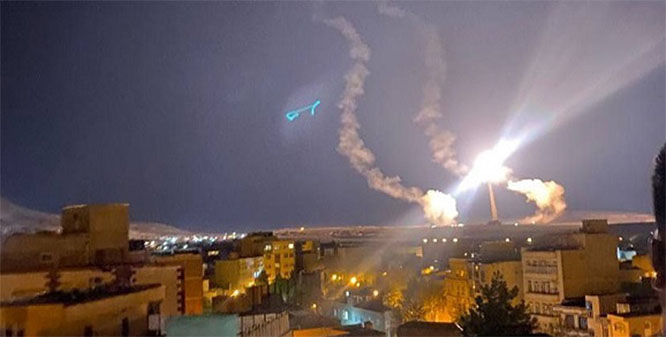Tehran: Iran’s Islamic Revolution Guards Corps (IRGC) has launched “extensive” retaliatory missile and drone strikes against the occupied territories in response to the Israeli regime’s terrorist attack of April 1 against the Islamic Republic’s diplomatic premises in the Syrian capital Damascus.
The Corps announced launching the strikes in a statement on Saturday night, defining the mission as "Operation True Promise."
“In response to the Zionist regime’s numerous crimes, including the attack on the consular section of Iran’s Embassy in Damascus and the martyrdom of a number of our country’s commanders and military advisors in Syria, the IRGC’s Aerospace Division launched tens of missiles and drones against certain targets inside the occupied territories,” the statement read.
Iran's Defense Minister Brigadier General Mohammad Reza Ashtiani, meanwhile, warned that “Whatever country that could open its soil or airspace to Israel for a [potential] attack on Iran, will receive our decisive response.”
The Israeli attack had resulted in the martyrdom of Brigadier General Mohammad Reza Zahedi, a commander of the IRGC's Quds Force, his deputy, General Mohammad Hadi Haji Rahimi, and five of their accompanying officers.
The terrorist attack drew sharp condemnation from senior Iranian political and military leaders, who vowed "definitive revenge."
During a speech in Tehran on Wednesday after leading the Eid al-Fitr prayers, Leader of the Islamic Revolution Ayatollah Seyyed Ali Khamenei said the Israeli regime “must be punished and will be punished” for the deadly strike on the Iranian diplomatic premises.
The Leader added, “The evil Zionist regime committed another mistake ... and that was the attack on the Iranian consulate in Syria. The consulate and diplomatic missions in any country are considered to be the territory of that country. When they attack our consulate, it means they have attacked our soil."
In a subsequent statement, the IRGC said the retaliation came after 10 days of "silence and neglect" on the part of the international organizations, especially the United Nations Security Council, to condemn the Israeli aggression or punish the regime in line with Article 7 of the UN Charter.
Iran then resorted to the retaliatory strikes, the Corps added, "using its strategic intelligence capabilities, missiles, and drones" to attack "targets of the Zionist terrorist army in the occupied territories, successfully hitting and destroying them."
The statement, meanwhile, warned the United States -- the Israeli regime's biggest supporter -- that "any support or participation in harming Iran's interests will result in a decisive and regrettable response by the Armed Forces of the Islamic Republic."
"Furthermore, America is held responsible for the evil actions of the Zionist regime, and if this child-killing regime is not restrained in the region, it will bear the consequences," it noted.
The Corps concluded the statement by cautioning third countries against letting their soil or airspace be used for attacks against the Islamic Republic.







Comments
Add new comment